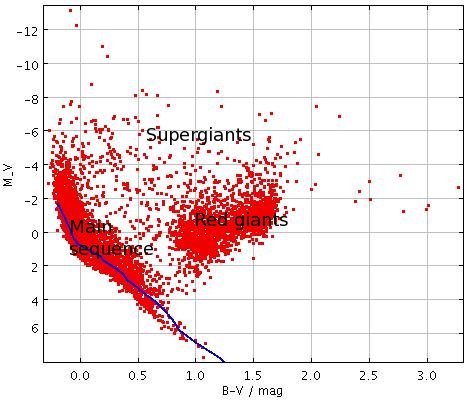Of the stars that can be seen with the naked eye, what are the distributions of each type? For example, how many are main sequence? how many are Super Red giants/white dwarfs/neutron stars...etc. What's the distribution by mass and distance?
-
$\begingroup$ For your first question - About 6000 stars on a really dark night. I don't have a citation for this number though. $\endgroup$– KitchiCommented Oct 12, 2013 at 11:40
-
$\begingroup$ It should also be noted that several of the "stars" in the sky are actually galaxies $\endgroup$– Zo the RelativistCommented Oct 12, 2013 at 17:36
-
$\begingroup$ The overall scaling @Kitchi refers to is discussed here, and in particular this answer cites a source for the 6000 (though that source could stand to be clearer on their methods). $\endgroup$– user10851Commented Oct 14, 2013 at 7:01
3 Answers
Most of the brightest stars are nearby main sequence stars with spectral types B, A and F (50%, e.g. Sirius, Altair, Vega), but there are also a bunch of more distant O-type main sequence and giant stars (5%, e.g. Regor, Naos) and another big clump of red giants (about 35%, e.g. Arcturus, Aldebaran) and a few percent are distant supergiants (e.g. Deneb, Rigel, Betelgeuse). There are no white dwarfs, and definitely no neutron stars!
I have attached an image which I created by selecting 4992 bright (V<6, hence visible from a good site) stars from the new, revised, Hipparcos catalogue (van Leeuwen 2007) with a parallax and plotted them on the absolute V magnitude vs B-V colour-magnitude diagram (analogous to the Hertzsprung-Russell diagram). Also shown is a zero age main sequence for stars $<7M_{\odot}$ from Siess et al. (2001).
I also show a histogram of their log10(distance) in parsecs. It's basically lognormal with a peak at about 150pc (about 500 light years). I'm afraid mass is not so straightforward - the Hipparcos catalogue can be found at http://cdsarc.u-strasbg.fr/viz-bin/Cat?I/311 if you fancy doing it yourself
Actually as a postscript, one thing we can say about the mass distribution is that if you look at the HR diagram you see that almost all the stars either (a) have evolved to become giants and therefore must have masses $>0.9M_{\odot}$ to have done so during the time the Galaxy has existed or (b) are main sequence stars more luminous than the Sun ($M_{V,\odot} = 4.75$) and so must be more massive. So notably, all but a handful of stars visible to the naked eye are more massive than the Sun.


-
2$\begingroup$ Great answer. tells me something that isn't obvious. Almost every star you see is bigger than the sun. $\endgroup$ Commented Apr 21, 2018 at 19:39
Here's a parsing of the hipparcos star catalogue showing the demographics of stars with magnitude > 6.5
For comparison, here's the sample presentation of an equal size random sample of the entire catalogue
apparently, the stars you can see have a bias towards giants. and none of what you see are white dwarves (I suspect that the one that shows up is anomalous as it's in the wrong part of the H_R diagram)
mass is challenging but here's a comparison of the distances of visibles versus the full catalogue

-
$\begingroup$ The graphs show stars with abs. mag of <-20. No such stars exist (see my plot). Your histograms peak at >1e4 parsecs. Again, see my correct plot. You don't say how you have got your classifications, but it appears only loosely related to where they are in the HR diagram. There are no naked-eye white dwarf stars. $\endgroup$– ProfRobCommented Apr 22, 2018 at 6:53
-
$\begingroup$ thanks Rob. classification comes from text parsing of the 'spectral type' field in the hipparcos catalogue. absolute magnitude is calculated as ( 'hpmag' - 5*log(paralaxDist/10). should I just use B-V mag instead? is there a better calculation for absMag? $\endgroup$ Commented Apr 23, 2018 at 16:29
I can have a stab at estimating the Neutron star population, and perhaps suggest how to do the others.
Now as far as I'm aware there aren't any Neutron stars you can actually see with the naked eye as there cold dead stars and we mostly observe them as pulsars in the radio band. But anyway, this article estimates we can observe objects up to "a little over 4000 light years away, " so lets use that.
Now the way to do this is to find a database, for pulsars there is the excellent ATNF Pulsar Catalouge. The joy of this site it it allows you to enter a condition.
So we ask it for names of pulsars with the condition dist < 1.266. Here we had to convert light years to kpc as that is the unit used by ATNF. The output gives us 146 objects.
You can repeat this exercise if you can find similar online catalouges for the other objects your interested in, I'm afraid I only know about Pulsars.
-
$\begingroup$ I thought many neutron stars were still hot, due to the fact that, immediately prior to the collapse event, the neutron star was basically a stellar core. $\endgroup$ Commented Oct 12, 2013 at 17:37
-
$\begingroup$ @JerrySchirmer. Having though about it and done some reading I think your correct. The closest NS to us is about 50000K so two orders of magnitude brighter than the sun. However, I still don't believe they are visible to the naked eye. $\endgroup$– GregCommented Oct 12, 2013 at 17:52
-
1$\begingroup$ Neutron stars may be very hot, relative to the sun, but they are also tiny, and quite a long way away. None are visible without a telescope. $\endgroup$– Dr ChuckCommented Mar 28, 2014 at 19:22


